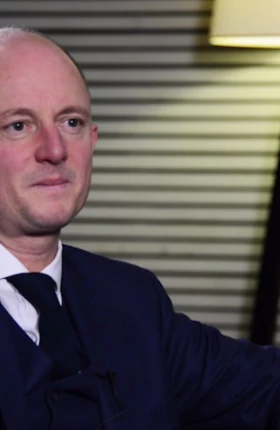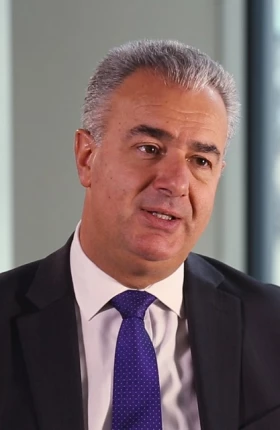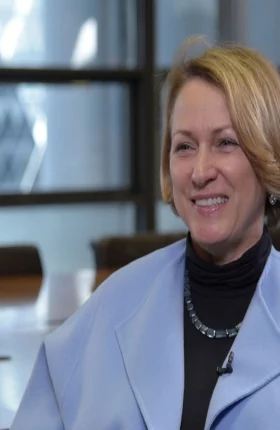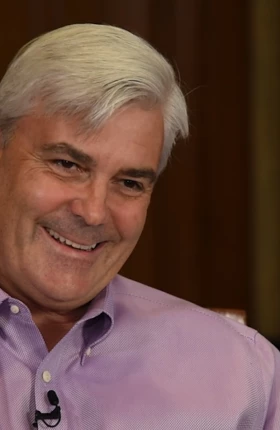Despite its 158-year history, Royal London was a little-known player when Phil Loney joined as group chief executive in 2011. Since then, he has transformed the business into a market leader: from 2011 through 2018, European embedded value operating profit before taxes grew by 76% to £396 million, assets under management more than doubled to £114 billion, and new life insurance and pension sales nearly quadrupled to £11.3 billion, making Royal London the UK’s largest mutually-owned life and pension provider.
Preparing to step down by the end of 2019, Loney recently spoke with Benoît Macé, a partner and managing director at Boston Consulting Group, about the steps he had taken to reshape the business. The following is an edited version of their conversation.
About Phil Loney
About Phil Loney
Year Born: 1964
Married, two daughters
Education
Bachelor’s degree, economics, Durham University, UK
Career Highlights
2011–present, group chief executive, Royal London Group
2011–present, board member, Association of British Insurers
2003–2011, managing director, general insurance; managing director, life, pensions, and investments, Lloyds Banking Group
2000–2003, chief operations officer, AXA UK Life & Pensions
1997–2003, managing director direct business, Aviva, formerly CGU
1995–1997, sales and marketing director, Saga Services
1990–1995, general manager, Lloyds Bank Insurance Direct
What was Royal London like when you took over?
When I joined, the company was coming to the end of a period of growth through acquisition. It did not trade as Royal London but as a number of brands. The company had grown by providing simple life insurance plans. It had a sales force of about 3,000 home service agents at the turn of the century. That model ended in 2001, when the sector became regulated, leaving Royal London without a distribution capability. The company then went through a decade of acquisitions, consisting mainly of small to midsize mutual insurers, many with an intermediary distribution model through independent advisors.
This strategy provided growth and some important future optionality, but by 2011 it was running out of road. There were fewer sizable acquisition targets remaining. The acquired businesses were not integrated. They operated as independent units with their own technology stacks and brands, each relatively subscale and typically outside the top four players in each franchise. In a consolidating market, that didn’t look like a recipe for sustainable success. The competition was getting bigger, and we lacked a clear organic growth strategy.
What did you do?
We needed to develop a way forward—one built on three pillars: a competitive strategy rooted in our mutuality, new sources of sustainable growth, and a groupwide operating model. The model would feature a single brand that resonated with the public, as well as a common set of capabilities and technology solutions that could be shared across the group, supporting a better customer experience and lower unit costs. In 2011, we had a very federated model, so this involved a major realignment.
What growth options did you consider?
We had three options. One was to become more focused: specialize in pensions, protection, or asset management. But we asked ourselves, As we are the largest mutual insurer in the UK, is being a niche player really our purpose? Besides, I believe in the value of diversification. As annuity providers found after the pension freedom legislation was passed in 2015, markets can disappear overnight. And given our modest scale and multiple processes, it wasn’t realistic to imagine Royal London as a low-cost player in the market. So we went for a third differentiated option. This consisted of growing our business organically by meeting the needs of our customers and their financial advisors—and doing that better than the competition.
What did this growth strategy consist of?
We looked at our most successful businesses: Scottish Life Assurance, a pension plan provider, and Royal London Asset Management. Both had been successful by serving a distinct customer segment accessed through a specific subset of advisors or consultants: the tailored solutions they offered fitted the needs of these segments better than the competition’s solutions. But was it a scalable strategy? We discovered that there were significant segments that were not simply price led but would also value a differentiated, bespoke proposition that would result in better outcomes and experiences for customers and their advisors. At the time, our competitors were mainly developing a one-size-fits-all approach. Many were competing with the advisor community.
We also saw opportunities to move into adjacent sectors. With the arrival of automatic enrollment, we expanded into workplace pensions. But we were clear about where we would participate, targeting high-quality small and midsize companies assisted by a specific group of independent financial advisors—in that case, corporate IFAs. In protection, we identified a new opportunity in the over-50 market. Those consumers were receiving poor value and outcomes, so we launched a direct-to-the-consumer proposition, offering a fairer deal. We extended our institutional franchise within our asset management business and also built out a wholesale franchise.
How did you adapt the group’s operating model?
We knew that the main strategic concern was the threat of being copied and beaten on price. So we created a goal of operating a broad range of differentiated customer propositions using a common operating model to reduce unit costs. This involved centralizing IT and customer service and building stronger centralized risk and people functions. We established a plan to develop a new set of technology solutions that our businesses could share. We are migrating all our customers to these solutions over time. In line with our portfolio, I decided to streamline our business units into three divisions: intermediary (focusing on our intermediated pensions and protection businesses), asset management, and consumer (in which we launched our direct-to-consumer protection offering alongside our legacy business). Business units would retain control over products, channels, pricing, and go-to-market strategies, but they had to use common technology solutions with support and control functions provided by the center. In return, they would benefit from the heavy investments we were making in operational capabilities and the lower unit costs of a neater operating model, enabling stronger digital and data capabilities.
How did that strategy deliver?
After about two years, we reached a tipping point. Three actions were key to guiding the group over that point: changing the leadership team, getting hold of the investment agenda to stop the businesses from doing their own thing, and establishing a stronger single brand and common culture. I was delighted by how well the new brand and culture were received internally. The focus on customers and fairness tapped into the organization’s DNA.
Growth significantly exceeded our plans: sales nearly quadrupled and assets under management more than doubled. This growth was partly due to the markets we entered and partly the result of refreshing our customer propositions and joining forces where we had competing brands. Our differentiated propositions allowed us to gain market share. We became one of the top four players in our segments, and we have developed stronger public awareness of the Royal London brand through advertising and sponsorship. There was also some luck: the new pension freedom legislation meant that drawdown products became the mass market’s retirement vehicle of choice, and we had a strong starting position there. As we grew, we reinvested the surplus that we generated into delivering greater value to our customers and expanding our profit sharing with members. To us, this is what it means to be a mutual.
What role did technology play in this journey?
We inherited more than 200 legacy IT platforms from various acquisitions. Six years ago, we identified 13 different technology solutions we wanted to move to. We upgraded our general ledger, we deployed a new advisor portal for our protection business, and we are replacing our advisor wrap platform and pension administration systems. As we do this, we are investing heavily in digital front ends, allowing us to digitize advisor and customer journeys. As a critical enabler of this digital agenda, we deployed agile ways of working in the intermediary business, our largest division. We are migrating our existing customers to these new platforms so that we get the benefits of lower unit costs and a neater operating model. Furthermore, we are investing in advanced analytics to enhance customer-facing processes and offer more personalized and efficient customer engagement. In a consolidating market, having a slick and efficient operating model is critical to maintaining competitive prices.
What challenges could Royal London face in the future?
I see three areas in which we’ll need to keep investing. We have doubled consumer recognition for the Royal London brand in recent years, but we still have a way to go to be a truly differentiated brand. I believe we have built enough points of difference to evidence our mutually inspired ethos in our brand building, allowing us to be broadly recognized and trusted as an organization that is on the side of customers.
Scale and unit costs are always going to be a focus so that our propositions remain excellent value for money. We need to keep our unit costs down through high-quality technology and automation. Our primary focus since 2011 has been organic growth, but we also acquired businesses from Royal Liver Assurance and Co-op Insurance, which added £20 billion of assets under management. Time will tell if relevant acquisitions may complement and accelerate our organic-growth strategy.
Last, we will need to keep adapting to changing consumer needs. Long-term savings remain a predominantly advised market in the UK. But I see digital playing a growing role in customer journeys, and I believe that there is a need for more guidance to complement regulated financial advice. The bancassurance sector is developing digital models. Meanwhile, some of our competitors are vertically integrating by buying advice firms. How can we support impartial advisors so that they continue to be the key source of unbiased advice and healthy arbitrage in the UK? In addressing such issues, our focus remains on how we can improve value for customers, particularly those customers who own our business.





